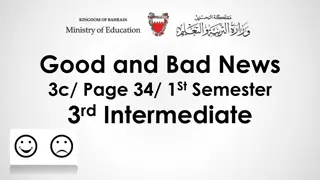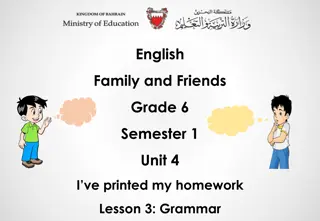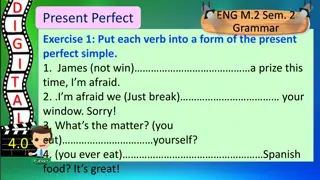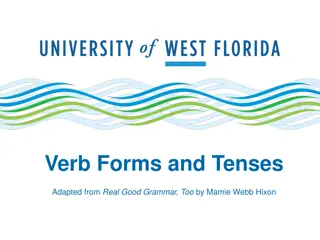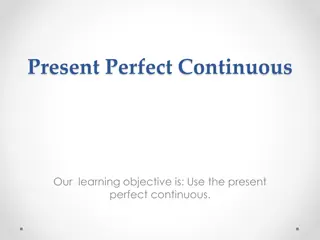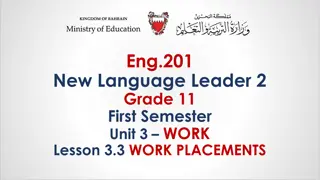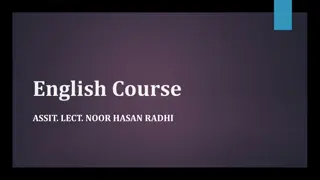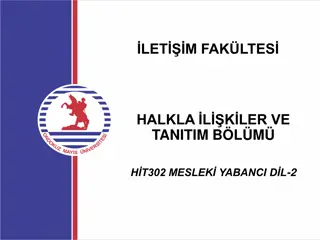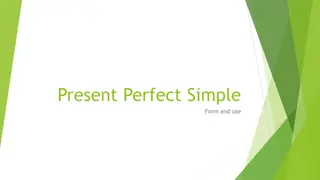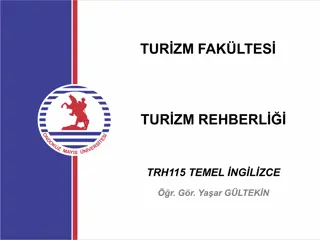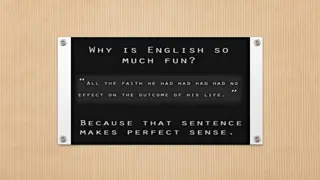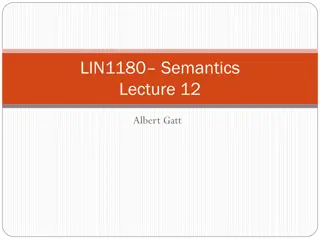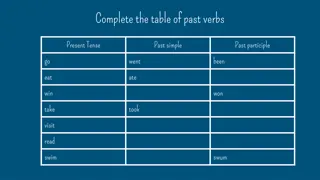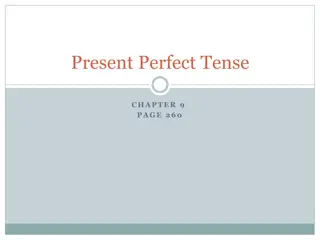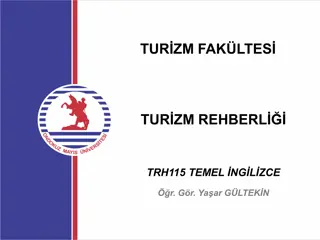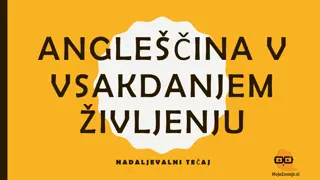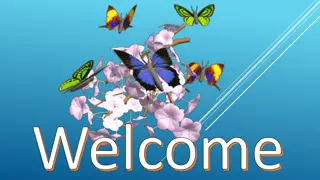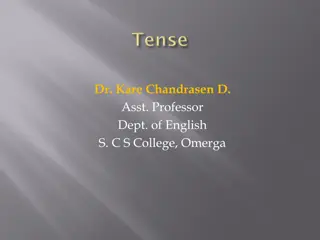Understanding the Present Perfect Tense in English Grammar
The lecture notes explore the Present Perfect tense, highlighting its connection between past actions and their relevance in the present. It compares the Past and Present Perfect tenses, discussing the nuanced differences and providing examples for clarity. The document covers the usage of the Present Perfect Simple and Continuous forms, emphasizing unfinished past actions, present results of past actions, and experiences at an unspecified time in the past.
Download Presentation

Please find below an Image/Link to download the presentation.
The content on the website is provided AS IS for your information and personal use only. It may not be sold, licensed, or shared on other websites without obtaining consent from the author. Download presentation by click this link. If you encounter any issues during the download, it is possible that the publisher has removed the file from their server.
E N D
Presentation Transcript
NEW HEADWAY PLUS UPPER-INTERMEDIATE LECTURE NOTES Fourth Year College of Law Mustansiriyah University Asst. Lect. Rania Adnan Aziz
Unit 2 Been there, done that! Grammar Reference PRESENT PERFECT The Present Perfect tense is a mixture of the past and the present. It relates past actions to the present. In other words, the actions started in the past, but their results or continuity are seen in the present. The difference between the Past and Present Perfect is that the action in the Past tense started, happened and finished in the past, while the action in the Present Perfect started in the past and is connected to the present. See Figure 1 below. Has written Past Present Future Played Figure 1: Timeline showing Past and Present Perfect tenses. When we come across a verb in the Past Simple tense, we want to know when it happened. When we come across a verb in the Present Perfect tense, we want to know how it affects the situation now. Compare these examples: She wrote three letters yesterday. (Only three and no more.) She has written three letters since yesterday. ( so far, and may write more.) 2
Unit 2 Been there, done that! Grammar Reference USEOFTHEPRESENTPERFECTSIMPLEANDCONTINUOUS 1. Unfinished past The verb action began in the past and continues to the present. It possibly goes on into the future, as well. We ve lived in this house for twenty years. (and we still live in here.) Notice! *Sometimes there is little or no difference between the two tenses. I ve played tennis since I was a kid. I ve been playing *The continuous can sometimes suggest a more temporary situation. The simple can sound more permanent. I ve been living with a host family for six weeks. I ve lived in this city for a very long time. *Certain verbs suggest duration: wait, rain, snow, learn, sit, lie, play, stay. They are often found in the continuous. It s been raining all day. *State verbs do not take the continuous. I ve known Jane for years. 3
Unit 2 Been there, done that! Grammar Reference USEOFTHEPRESENTPERFECTSIMPLEANDCONTINUOUS 2. Present result The verb action happened in the recent past and its results are felt now. I m covered in mud because I ve been gardening. (Because of the gardening that started in the past you see me covered in mud now.) The simple emphasizes the completed action. The continuous emphasizes the repeated activities over a period of time. Notice! *Certain verbs suggest a short action: start, find, lose, begin, stop, break, die, decide, cut. I ve broken the vase. In the continuous, these verbs suggest a repeated activity. I ve been stopping smoking for years. *The use of the simple suggests a completed action. The continuous suggests a possibly incomplete action. I ve painted the bathroom. I m tired because I ve been working. (Finished? Unfinished?) *The continuous can be found unqualified by any further information. The simple sounds quite wrong in this use. I m wet because I ve been swimming. *Sometimes there is little difference between the Past Simple and the Present Perfect. did you put my keys? Where have you put 4
Unit 2 Been there, done that! Grammar Reference USEOFTHEPRESENTPERFECTSIMPLEANDCONTINUOUS 3. Indefinite past The verb action happened at an unspecified time in the past. The actual time isn t important. We re focusing on the experience at some time in our life. She s been to Spain. (at some time in her life, but we don t know exactly when.) Notice these two sentences. She s been to Spain. (at some time in her life) She s gone to Spain. (and she s there now) The first is an example of indefinite past and the second is of present result. SHOWING REACTIONS We use some expressions to show our reactions to news or stories we hear. I didn t know that It s a shame that It must be really difficult for You add the information you hear after the expression that may show your surprise, sadness, anger, etc. see p.21, What do you think 1. 5
Unit 2 Everyday English Make and Do: Collocation Collocation Sometimes two or more words come together and may have their own meaning as a whole. This is called collocation. The verbs Make and Do come with certain words like way, connection, etc. Let s see these examples. Make way for, making the connection, doing their best, done the damage. Make sure to use such words together to give them a more specific meaning, See p. 23. Phrasal Verbs Phrasal verbs are verbs that appear with prepositions or adverbs. This gives them different meanings, not like the original meaning of the verbs when it comes alone. Examples: Do away with sth, do without sth, make sth of sb, make off with sth. See p.23. Note: Sb means somebody. Sth means something. Fillers Speakers can sometimes be vague and imprecise. They also use fillers. Fillers are words speakers use to fill the gaps when they speak. These words don t mean much. Example words are like, you know, I mean. P. 24 and 126. 6
Unit 2 Everyday English Exclamations Exclamations Exclamations are used in everyday conversation and have a certain usage/meaning. They express strong emotions such as surprise , disgust, amazement, delight, etc. They end with an exclamation mark (!) . There are two ways to express exclamation: by exclamation words, such as oops!, yuk!, phew!, ouch! And wow! or by comments with what, what a/an or how. Ha ha! Very funny! Oh! I m so sorry to hear that! What a shame! Eh? What did you say? Duh! You forgot to plug it in! Exercise 1 p.25 gives additional exclamation words and comments. 1- Mmm! It s absolutely delicious! 2- Wow! How interesting! 3- Hey, Peter! Come over here and sit with us. 4- Oh, really? That s unbelievable! How amazing! 5- Ah! What a shame! 6- Ouch! That really hurt! 7- Yuk/yuck! That s disgusting! 8- Uh? That s nonsense! What a stupid thing to say! 9- Phew! What a relief! Thank goodness for that! 10- Whoops/oops! Sorry about that! I dropped it! 7
Unit 2 Everyday English Exclamations used when we have a countable noun used when there is an uncountable noun or plural noun. used with adjectives and adverbs What a/an What How Exercise 5, p 25 shows how these words are used. What a silly mistake! What a brilliant idea! How utterly ridiculous! What dreadful weather! What rubbish! What a mess! How awful! How wonderful! What a relief! 1. 2. 3. 4. 5. 6. 7. 8. 9. 10. What a terrible thing to happen! See if you can put the correct word in the following blanks: -------- nice hotel -------- hot it is! -------- elegant dresses! -------- beautifully you sing! -------- nice hair you have! 1. 2. 3. 4. 5. 8


